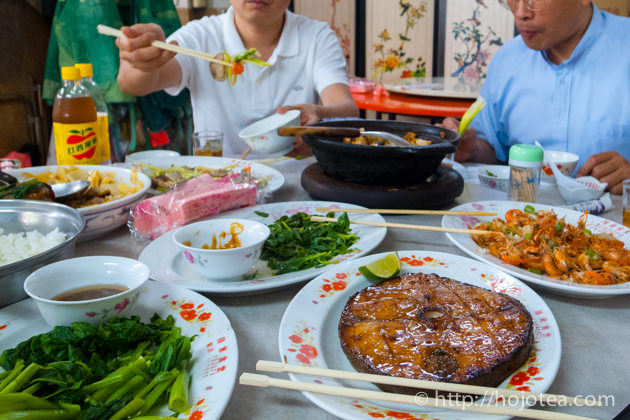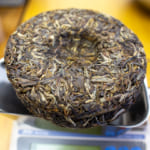- HOME >
- Tea Column
Regular Consumption of Umami Seasoning Can Influence Taste Preferences
- [2023.10.05] Posted By Akira Hojo

Excessive consumption of artificial condiments, such as umami seasonings, is believed to influence one’s taste and preferences. I’d like to share my own view to explore how an overabundance of condiments can indeed influence one’s palate.
Umami Seasonings Are Prevalent in Asian Countries
I spend half of the year living abroad, particularly in China and Southeast Asia, with a focus on countries like Malaysia, Singapore, and Taiwan. When dining out in these regions, I can’t help but observe a much more frequent and liberal use of monosodium glutamate (commonly known as MSG and produced by Ajinomoto Co., Inc.) compared to Japan. For example, during my stay in Kuala Lumpur, the capital of Malaysia, I noticed that MSG was frequently used as a seasoning in numerous eateries across the city. It was quite a noticeable trend in the local culinary scene.
The distinction between natural broths and artificial umami seasonings
Both chicken broth and Japanese kombu dashi contain umami components. However, it’s important to note that the umami component present in these natural broths primarily consists of glutamic acid, while artificial umami is associated with the chemical seasoning known as monosodium glutamate (MSG).
On the other hand, amino acid and nucleotide seasonings, widely distributed worldwide, undergo a synthesis process involving sodium attachment, leading to the formation of salts. This transformation into salts imparts their distinctive umami taste but can also introduce an unnatural sensation, which may differ from the experience of natural broths.
The Unique Flavor Profile of Monosodium Glutamate (MSG)
Monosodium glutamate (MSG) is commonly associated with its umami taste, but it offers a range of distinctive taste characteristics that go beyond umami.
MSG contributes to a pronounced fullness and richness in taste, creating a distinctive sensation on the palate, in addition to enhancing the umami effect.
The elevated sense of fullness and richness can be attributed to the presence of sodium. Alkaline minerals like calcium, potassium, and sodium play a role in enhancing the body of the taste.
When discussing glutamic acid in natural broths, it’s important to note that, due to its absence of sodium, it contributes to umami without the overwhelming richness found in MSG, resulting in a comparatively more refreshing and clean taste.
The Influence of Excessive Monosodium Glutamate (MSG) Consumption on Flavor Perception
The use of monosodium glutamate (MSG) in cooking significantly amplifies the body of the taste, making it richer, and simultaneously, the added umami makes many people find it delicious. MSG not only bolsters the body of the taste, imparting a greater sense of indulgence, but it also introduces an additional umami element that numerous people find particularly enjoyable.
While some individuals, like myself, may not have a preference for the distinct artificial umami taste and the excessive richness often associated with umami seasonings, it’s essential to acknowledge that MSG remains a popular choice for many. Consequently, many restaurants actively incorporate MSG into their dishes. This trend is especially noticeable in various Southeast Asian countries, Taiwan and big cities in China, where it’s commonly believed that the generous use of MSG can contribute to improved sales and customer satisfaction.

The Impact of Monosodium Glutamate (MSG) on Taste Preferences
The widespread use of monosodium glutamate (MSG) has led to a significant shift in taste preferences, with many individuals now favouring a robust body (rich taste) in their food. Interestingly, this preference for body is sometimes mistakenly equated with flavor intensity. This phenomenon is particularly pronounced in South East Asia, where even in the realm of tea, a substantial number of customers consistently seek out a strong body. Some customers have noted that, even in naturally cultivated teas with a pronounced aftertaste, the absence of a strong body can lead to a perception of weak flavor. They often describe the taste as “light” or not strong enough.
Personally, when it comes to selecting tea, I prioritize the depth of its aftertaste as an indicator of its quality. I used to pay less attention to the strength of the body, until about a decade ago. Consequently, during that period, HOJO’s selection included relatively few teas with a strong body, which occasionally led to feedback from customers about the teas tasting weak. Based on these experiences, in recent years, I’ve made a conscious effort to offer roughly half of our tea lineup with a strong and rich body, while the remaining options feature a lighter body for those seeking a more refreshing taste. However, regardless of body strength, the enduring aftertaste of tea remains a fundamental criterion guiding our sourcing decisions.
In Regions with Minimal MSG Usage, the Focus Shifts to Aftertaste
In the remote mountainous regions of Yunnan Province and Chaozhou, which I visit annually, the use of monosodium glutamate (MSG) is less prevalent compared to other areas. Particularly in the remote mountains of Yunnan Province, MSG is not commonly used, and locals tend to prepare broth by simmering ingredients like chicken bones to extract flavor. Additionally, in Japan, many traditional dishes emphasize the purity of ingredients, as seen in sashimi, sushi and tempura, which means that unless one frequently dines out, the intake of MSG remains relatively low compared to Southeast Asia.
In regions where MSG consumption is limited, people prioritize the depth of the aftertaste, and there is less demand for a strong body in their culinary experiences.
Especially when delving into the remote mountains of Yunnan Province, a notable trend emerges among tea producers—an unwavering focus on the depth of a tea’s aftertaste. In these regions, teas crafted from ancient tea trees grown naturally, renowned for yielding a more profound aftertaste, command higher prices. This pricing structure arises from the strong demand for teas with such flavorful characteristics. This relationship fosters a healthy dynamic wherein the depth of the aftertaste, which serves as a reflection of the tea materials’ quality, is directly translated into its market value and pricing.
A similar pattern can be observed in the world of Fenghuang Dancong Oolong tea, particularly in Chaozhou. To put it simply, in regions where culinary traditions typically exclude umami seasonings, individuals tend to associate the depth of the aftertaste with flavor intensity. On the flip side, in regions where umami seasonings are commonly used, there’s a belief that a tea’s body (its strength) is directly related to its flavor intensity. This difference in preferences highlights the interesting connection between regional cooking customs and how people interpret the taste of tea.
Related Articles
How to get the latest update on HOJO?
1. Follow Twitter, 2. Click "Like" on Facebook, and 3. Subscribe in newsletter. You can have the latest tea news from HOJO.
 Subscribe the Newsletter to enjoy the privileges
Subscribe the Newsletter to enjoy the privileges- You may receive a free sample upon purchase, or you may have the priority to purchase special products. So please remember to subscribe our newsletter as well as the social network.
- New Arrival of Akitsu Mumyoi and Nosaka Rough Clay Teapot
- A wide selection of teaware by Watanabe Tozo, a Sado-based artist of Mumyoi-yaki, has just arrived. This time, …
- Mang Fei Ripe Pu-erh Tea 2023 – Small-Batch Production from a Renowned Region
- Mang Fei Ripe Pu-erh Tea 2023 is now available. This is one of the highest-quality ripe pu-erh teas among our …
NEW ARTICLES
 Development of Firewood Roasted Hojicha Using Naturally Grown Tea from Yunnan
Development of Firewood Roasted Hojicha Using Naturally Grown Tea from Yunnan- We are currently staying in Yunnan Province for tea production. As the season nears its end, tea trees with pa …
 Exploring the Food Culture of Yunnan: Where Minority and Sichuan Cuisines Meet
Exploring the Food Culture of Yunnan: Where Minority and Sichuan Cuisines Meet- We are currently staying long-term in Yunnan Province for spring tea production. On rainy days or when there i …
 New Arrival of Akitsu Mumyoi and Nosaka Rough Clay Teapot
New Arrival of Akitsu Mumyoi and Nosaka Rough Clay Teapot- A wide selection of teaware by Watanabe Tozo, a Sado-based artist of Mumyoi-yaki, has just arrived. This time, …
 Managing Yunnan White Tea — Insights from the Field
Managing Yunnan White Tea — Insights from the Field- Since March 25, we have been in Yunnan Province, fully engaged in the production of white tea. In this column, …
 Mang Fei Ripe Pu-erh Tea 2023 – Small-Batch Production from a Renowned Region
Mang Fei Ripe Pu-erh Tea 2023 – Small-Batch Production from a Renowned Region- Mang Fei Ripe Pu-erh Tea 2023 is now available. This is one of the highest-quality ripe pu-erh teas among our …
 Yunnan Tea Trends 2025: Insights from the Fields
Yunnan Tea Trends 2025: Insights from the Fields- Since March 25, we have been in Yunnan Province. We will stay here until May to conduct tea production, packin …
 Why Do Some Teas Taste Astringent? Exploring the Causes and Mechanisms of Astringency
Why Do Some Teas Taste Astringent? Exploring the Causes and Mechanisms of Astringency- Tea can range from having no noticeable astringency to possessing a very strong one. What causes this astringe …
 The Impact of Heat Sources on Tea Flavor
The Impact of Heat Sources on Tea Flavor- It is widely recognized that the material of a kettle plays an important role in shaping the taste of water fo …
 New Release of Tang Li Shan Ripe Pu-erh Tea 2023
New Release of Tang Li Shan Ripe Pu-erh Tea 2023- We have released the 2023 edition of Tang Li Shan Ripe Pu-erh Tea. Tang Li Shan refers to a mountain located o …
 The New Release of Dong Shan Raw Pu-erh Tea 2023 and Jasmine Silver Needle
The New Release of Dong Shan Raw Pu-erh Tea 2023 and Jasmine Silver Needle- We have released Dong Shan Raw Pu-erh Tea 2023 and Jasmine Silver Needle. Dong Shan Raw Pu-erh Tea 2023 We hav …
Category
- New Arrival at HOJO Online Shop
- Featured Articles
- Newsletter
- Types of Tea
- Origin of Tea
- Teapot and Tea Equipment
-
Tea Column
- How to enjoy tea
- Tea Processing
- How to choose quality tea
- Tea constituents and functional effect
- Safety of Tea
- Foods
- Tea Business Operation
- Hobby and Outdoor Activity
- Ranking of Tea
- Video
- FAQ
- Media Release
Profile

- AKIRA HOJO
- I invite you to experience my tea selections.I was born in Nagano, Japan. In university, I studied agricultural chemistry, and I have the master degree in food science. I worked in Japanese food industry for 10 years. I involved in R&D, QC and QA. As a factory manager, I implemented ISO9000 series and managed the factory.
- The Art of Tea Magazine
- We posted the article on “The Art of Tea Magazine No.9, the magazine is published in Taiwan. We featured …
- New Straits Times
- The Malaysian National Newspaper, New Straits Times featured HOJO Tea on 17-Oct-2007.
Shop Info

Address:Lot No. T-215, 3rd Floor, The Gardens Mall, Mid Valley City, Lingkaran Syed Putra, 59200 Kuala Lumpur
Tel: +603-2287-4537
Business Hour: 10am to 10pm















